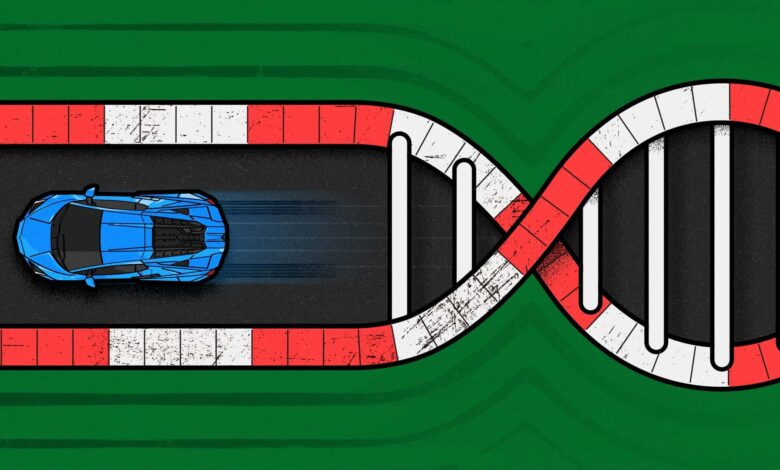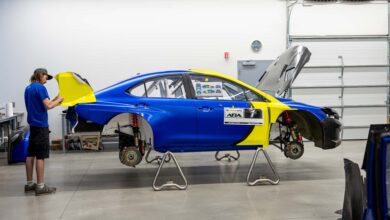How Lamborghini Makes Lamborghinis Feel Like Lamborghinis

[ad_1]
Rouven Mohr, Lamborghini’s Chief Technical Officer, explains that while a Urus and a Revuelto are very different cars, they’re held to similar standards.


May 24, 2024 at 10:00am ET
How a car feels to drive is as important to how it performs objectively.
Oftentimes, a car’s subjective qualities are a byproduct, a result of choices made solely to hit objective targets. In better cars, it’s no accident at all—it’s the result of carefully considered choices. Rouven Mohr, Chief Technical Officer at Lamborghini, concerns himself with these choices. He says it’s not rocket science. We’re still not entirely sure.
“In the end, it’s a question of prioritization,” he explains to Motor1. “How important is this during your development process? And then it’s a lot of work to do because for the last 20 percent [of a car’s development], you spend 80 percent of your effort.”
The aim isn’t simply to make a car feel good in a vacuum. Lamborghini wants its cars to feel familiar to one another, whether an SUV or a supercar.
“Internally, we have a clear product DNA, which means that the basic behavior of the steering of the brakes, or the transition from neutral behavior to oversteering is the same in all our cars,” Mohr says. “The qualitative qualitative approach is the same, but the quantitative execution is different.”
As an example, the level of power-steering assistance in an Urus is going to be different from what you get in a Revuelto. But the electric assist on both cars will follow the same curve across the steering wheel’s travel—the amount of assistance differs, but the shape of the curve is the same. And that’s true for every element of a Lamborghini. The braking effort required in the Urus is, again, less than in the Revuelto, but Mohr notes that the curve of braking force vs pedal travel is similar, as are things like how and when ABS engages.
“We have a kind of DNA catalog where we say, ‘This is what makes a Lamborghini,’” Mohr explains. “A Lamborghini is characterized by A,B,C,D.”
It’s not something every automaker does. Mohr doesn’t name names, but he did describe a “super premium” manufacturer where you get into multiple of their cars and they feel unrecognizable from one another. By contrast, he says Porsche does a really good job of this. “You sit in a Porsche, the Porsche feels like a Porsche.”
Defining the curves, creating the DNA catalog is not exactly a simple job.
“It’s the translation of the subjective feeling to the objective engineering,” he says.
The way it goes is something like this: Mohr assembles a team made up with a variety of drivers, selected from a pool of engineers, test drivers, and pro racers. They go to the handling circuit at Nardò—the Volkswagen Group’s famous Italian proving ground—and try to determine what sort of behavior they want out of the car. As an example, Mohr explains a test to define corner-entry behavior.
“We took the same corner at Nardò and we defined exactly which kind of driving behavior we want to have at the corner entry,” he says. “Then we have a discussion, because if you speak about subjective experience, it’s always not only one opinion. You have opinion A,B,C,D. You discuss the advantages and disadvantages, and then for sure at the end, someone has to decide ‘This is our way we want to go.’”
That’s ultimately Mohr’s decision. It’s a tough one because, as he explains, ten people are going to have ten different opinions.
They’ll run lap times with Lamborghini models under development and competitor’s cars as well. The idea isn’t to make the absolute fastest car in the hands of a pro, but to make a car that the majority find approachable.
The Lamborghini Centenario at the Nardò handling course.
“We compare the best time with the worst time [in a car], and this delta, this difference, should not be so big,” Mohr explains. Some cars might generate a crazy good time, but only in the hands of a pro. Most other drivers will find cars like this too edgy, and the delta between best and worst will increase.
“We want to have the best driving experience for the customer, and not for race drivers to be honest,” Mohr says.
Arriving at the right setup isn’t something that’s done by chance, either. It requires extensive analysis.
“I mean, what is the advantage of a super sharp setup if the majority of the people are frustrated with it?” he says. “They cannot handle it, it’s too sharp, they feel uncomfortable, they cannot enjoy it. From my point of view, this is not the right philosophy for a street car.”
It’s useful to look at the many systems in a car as different levers that can be pulled in various combinations to achieve a certain result. Let’s take the corner-entry behavior we talked about earlier as an example. That’s defined by far more than simply the turning of front tires.
With the Revuelto, Lamborghini has independent electric motors on the front wheels. Lamborghini’s team must consider the Revuelto’s rear-wheel steering system, the ABS, the rear differential lock, traction/stability control, adaptive dampers, power steering, and active aerodynamics. All of those things (and many more) can affect the way the car enters a corner.
They’re all levers to pull. Setting up a car is akin to choosing which levers to pull, and how to pull them. “Setup,” in this case, considers far more than suspension and steering geometry, as it once was.
Given that cars are getting more complex, the job of coming up with a setup is only getting trickier. Lamborghini will very soon be all hybrid, which adds even more complexity. Hit the brake pedal in a Revuelto or Urus SE, for example, and the car has to decide how to blend the regenerative and friction braking systems, and how all the other non-braking systems affect the braking. In reality, it means that something different happens every time you hit the brake pedal based on variables too numerous to mention. The trick is to make the brake pedal feel the same every single time.
Sounds hard. Now apply that to every other system in the car. It feels like a small miracle it works at all; to make a number of very different cars all feel similar? To me, that sounds something like rocket science.
Top Illustration: Sam Woolley
Read more
[ad_2]
Source link




